This comes from www.bigindoortrains.com . Make a few or many, maybee enough for your very own Christmas village. Enjoy! Building a GlitterhouseThe house shown in the photo is a good starting product for learning to build "putz" houses.What You Will NeedIf you are going to build vintage-style cardboard houses, stop throwing away used, clean cardboard yesterday. Save cereal boxes, the backs of writing tablets, anything flat, firm and clean, that you can save. Please keep some corrogated cardboard on hand, too - it makes the best bases. In addition, for this project you'll need:
Note:: Our article on What You Need to Build Glitterhouses lists many other materials and tools that will help you work more quickly and effectively. Printing the Plans
Double-click on the plans above to see the large versions. You should be able to print the big version at the size you need either of the following ways.
If neither of those work, contact Paul and ask him for help - that's his department. :-) Building the Base
Note: For this project, Howard cut the base and fence pieces out at the same time. The fence pieces are made from card stock such as posterboard or cereal box cardboard. If you wish, you may use different materials for the fence, including miniature wooden snow fence from the craft store or a rustic rail fence you make from twigs. Cut And Glue The Base - Usually the best method is to make a base from layers of corrugated cardboard glued together in a sandwich. You then wrap and glue a strip of thin poster-board or cereal-box cardboard all around it to camouflage the rough edges of the corrugated cardboard.
Wrap the Base - When the base is built, you then cover it with white bond paper just like you would wrap a gift, except that all surfaces of the paper cover must be glued down to the box. A glue stick works great for this.
Note: More details about building bases are provided in our article: Building Glitterhouse Bases Attach the Fence - When the glue on the base has dried, glue the fence pieces to the base. Prime the Base - When all the glue has dried, paint the base with the flat white paint. This provides an even finish that will hold the acrylic paint and glitter. If the fence is made of card stock, prime it, too. Prepping the Structure PiecesThe house, roof, chimney, and chimney cap need to be cut from thicker cardboard, such as the cardboard from the back of a writing tablet.
Assembling and Painting the House
|
White glue works best if you apply a thin coat to each mating surface and wait a few moments for the glue to become tacky. Do not glue the house to the base until you have applied the glitter (below).
Note: Sometimes I add a sub-base to the house. This could be in the form of 1/4"-inch square pieces of balsa wood or strips of corrugated cardboard glued around the inside bottom edge of the house wall where it meets the base. This gives you a larger gluing surface for mounting the house to the base.
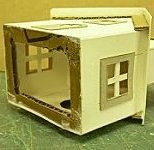 | 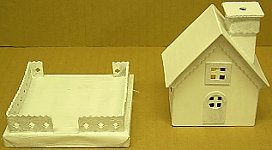 |
- Prime the house, including trim, with flat white wall paint. Don’t skip this step; it gives you a uniform surface for painting.
- Paint the house in your choice of colors. I use acrylics from the Wal-Mart craft department. For anything that is painted gold, silver or bronze, I use “Testors” brand model paint.
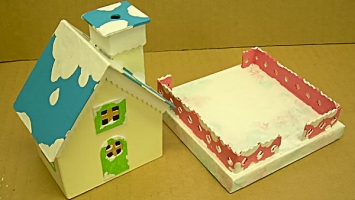 |
- Paint the base and fence. A white base with random swirls and dabs of very light pastel blue and pink are a good choice. Paint the fence a color that ties in with the rest of the house but is dark enough to contrast with the base. I suggest you not use yellows, beiges or greens in the snow.
- Add clear glitter to the house and the base. Brush on a thin, but even coat of undiluted white glue and sprinkle on the glitter. Don’t try to do the entire house or base at once. White glue starts to film-over and dry quickly so just do a wall or a section at a time. The glue dries clear so don’t judge the final look until the glue is dry.
- Glue the window covering material on the inside of the house. I use colored velum or colored “cellophane type” material. Red seems to be the traditional color but you can use any color you like.
- Glue the finished house to the finished base. Fill in any gaps between the house and the base with white glue and sprinkle on more glitter.
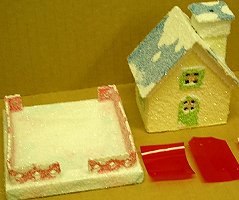 |
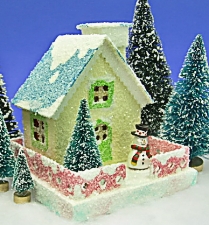 |
Adding Additional Scenery
Add yard accessories such as a small figurine and a bottle-brush tree.
I like to use miniature Christmas tree ornaments such as a Santa, deer and snowmen. You may even choose to make you own accessories.
[Editor's note: I have seen cheap party favors and cake decorations that were also suitable - it's okay if your accessories look a little "tacky." For trees, some folks cut apart a loofah sponge and dip it into deep blue-green paint, wring it out, and let it dry to simulate the lichen-like organic material used on some of the original houses. - Paul]
When everything is glued together and the glue has dried, touch up any place that the glitter hasn't covered evenly.
Conclusion
You can see that, when you get to the gluing, painting, and glittering stages, there's a lot of "hurry up and wait." That's one reason many people who build modern putz house recreations work on two or three houses at the same time - you can work on the second house while the glue is setting on the first one, and so on.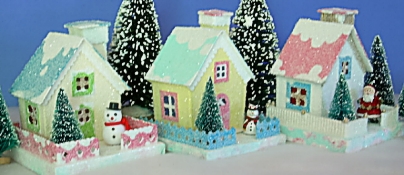 |
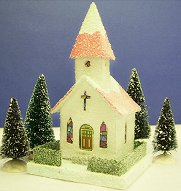 |
Bonus: Church Conversion Plans
When you're done with your first house, and thinking about the next project, here's an idea. Many glitterhouse sets had seven houses (often identical except for colors and accessories) and a church. If you want your glitterhouse collection to represent that tradition, you can use the plans below in addition to the plans and directions above to convert your next putz house into a church.
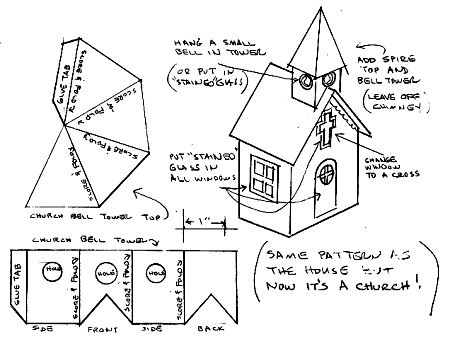 |
As always you have two options for downloading and printing the plan:
If you do build a church, you'll find a stained glass window pattern you can use on Paul Race's Free Large Scale Signs and Graphics web page.
Also, if you find yourself looking for the old-fashioned celophane with gold windowframes printed on it, you'll find many choices at Papa Ted's Reproduction Parts page.
The following photos show the steps in building a church the same basic way you build the little glitterhouse above. Note that in this version of the project, Howard changed the shape of the windows and added two, but the basic process is the same.
| Cut and score the building pieces according to the directions above. |
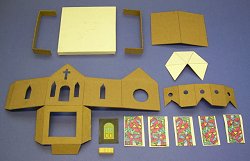 |
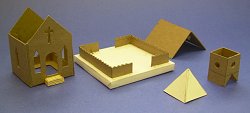 Put the sub-assemblies together to check the fit. Once you are satisfied that they will look right together, prime the subassemblies with flat white paint, paint the subassemblies, glue the windows in place, and glue the subassemblies together.
Put the sub-assemblies together to check the fit. Once you are satisfied that they will look right together, prime the subassemblies with flat white paint, paint the subassemblies, glue the windows in place, and glue the subassemblies together. 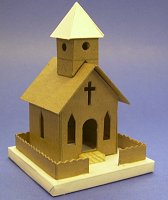 Finish with glitter and accessories according to the directions above.
Finish with glitter and accessories according to the directions above. 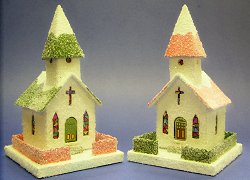


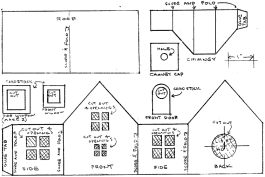
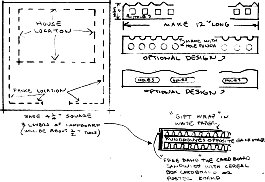
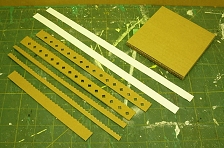
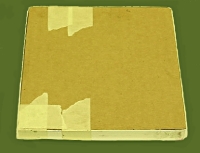
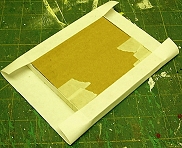
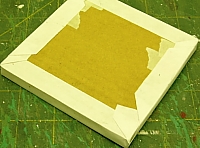
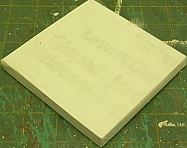
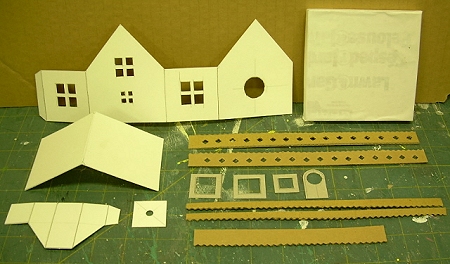
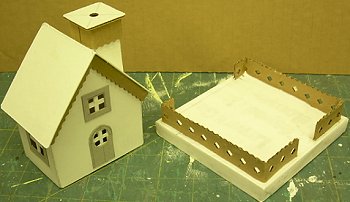
Tidak ada komentar:
Posting Komentar